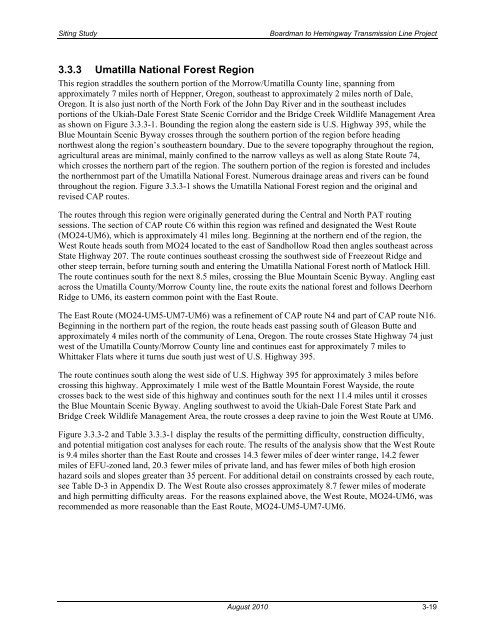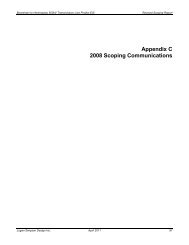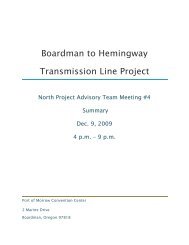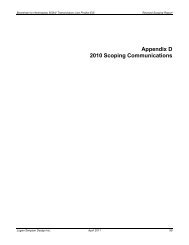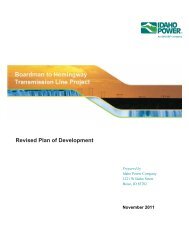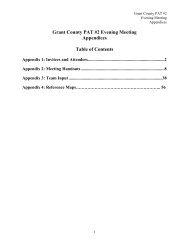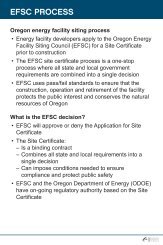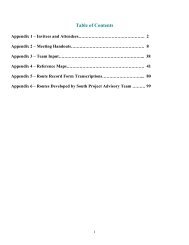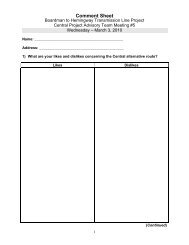Siting Study - Boardman to Hemingway Transmission Line Project
Siting Study - Boardman to Hemingway Transmission Line Project
Siting Study - Boardman to Hemingway Transmission Line Project
You also want an ePaper? Increase the reach of your titles
YUMPU automatically turns print PDFs into web optimized ePapers that Google loves.
<strong>Siting</strong> <strong>Study</strong><br />
<strong>Boardman</strong> <strong>to</strong> <strong>Hemingway</strong> <strong>Transmission</strong> <strong>Line</strong> <strong>Project</strong><br />
3.3.3 Umatilla National Forest Region<br />
This region straddles the southern portion of the Morrow/Umatilla County line, spanning from<br />
approximately 7 miles north of Heppner, Oregon, southeast <strong>to</strong> approximately 2 miles north of Dale,<br />
Oregon. It is also just north of the North Fork of the John Day River and in the southeast includes<br />
portions of the Ukiah-Dale Forest State Scenic Corridor and the Bridge Creek Wildlife Management Area<br />
as shown on Figure 3.3.3-1. Bounding the region along the eastern side is U.S. Highway 395, while the<br />
Blue Mountain Scenic Byway crosses through the southern portion of the region before heading<br />
northwest along the region’s southeastern boundary. Due <strong>to</strong> the severe <strong>to</strong>pography throughout the region,<br />
agricultural areas are minimal, mainly confined <strong>to</strong> the narrow valleys as well as along State Route 74,<br />
which crosses the northern part of the region. The southern portion of the region is forested and includes<br />
the northernmost part of the Umatilla National Forest. Numerous drainage areas and rivers can be found<br />
throughout the region. Figure 3.3.3-1 shows the Umatilla National Forest region and the original and<br />
revised CAP routes.<br />
The routes through this region were originally generated during the Central and North PAT routing<br />
sessions. The section of CAP route C6 within this region was refined and designated the West Route<br />
(MO24-UM6), which is approximately 41 miles long. Beginning at the northern end of the region, the<br />
West Route heads south from MO24 located <strong>to</strong> the east of Sandhollow Road then angles southeast across<br />
State Highway 207. The route continues southeast crossing the southwest side of Freezeout Ridge and<br />
other steep terrain, before turning south and entering the Umatilla National Forest north of Matlock Hill.<br />
The route continues south for the next 8.5 miles, crossing the Blue Mountain Scenic Byway. Angling east<br />
across the Umatilla County/Morrow County line, the route exits the national forest and follows Deerhorn<br />
Ridge <strong>to</strong> UM6, its eastern common point with the East Route.<br />
The East Route (MO24-UM5-UM7-UM6) was a refinement of CAP route N4 and part of CAP route N16.<br />
Beginning in the northern part of the region, the route heads east passing south of Gleason Butte and<br />
approximately 4 miles north of the community of Lena, Oregon. The route crosses State Highway 74 just<br />
west of the Umatilla County/Morrow County line and continues east for approximately 7 miles <strong>to</strong><br />
Whittaker Flats where it turns due south just west of U.S. Highway 395.<br />
The route continues south along the west side of U.S. Highway 395 for approximately 3 miles before<br />
crossing this highway. Approximately 1 mile west of the Battle Mountain Forest Wayside, the route<br />
crosses back <strong>to</strong> the west side of this highway and continues south for the next 11.4 miles until it crosses<br />
the Blue Mountain Scenic Byway. Angling southwest <strong>to</strong> avoid the Ukiah-Dale Forest State Park and<br />
Bridge Creek Wildlife Management Area, the route crosses a deep ravine <strong>to</strong> join the West Route at UM6.<br />
Figure 3.3.3-2 and Table 3.3.3-1 display the results of the permitting difficulty, construction difficulty,<br />
and potential mitigation cost analyses for each route. The results of the analysis show that the West Route<br />
is 9.4 miles shorter than the East Route and crosses 14.3 fewer miles of deer winter range, 14.2 fewer<br />
miles of EFU-zoned land, 20.3 fewer miles of private land, and has fewer miles of both high erosion<br />
hazard soils and slopes greater than 35 percent. For additional detail on constraints crossed by each route,<br />
see Table D-3 in Appendix D. The West Route also crosses approximately 8.7 fewer miles of moderate<br />
and high permitting difficulty areas. For the reasons explained above, the West Route, MO24-UM6, was<br />
recommended as more reasonable than the East Route, MO24-UM5-UM7-UM6.<br />
August 2010 3-19


